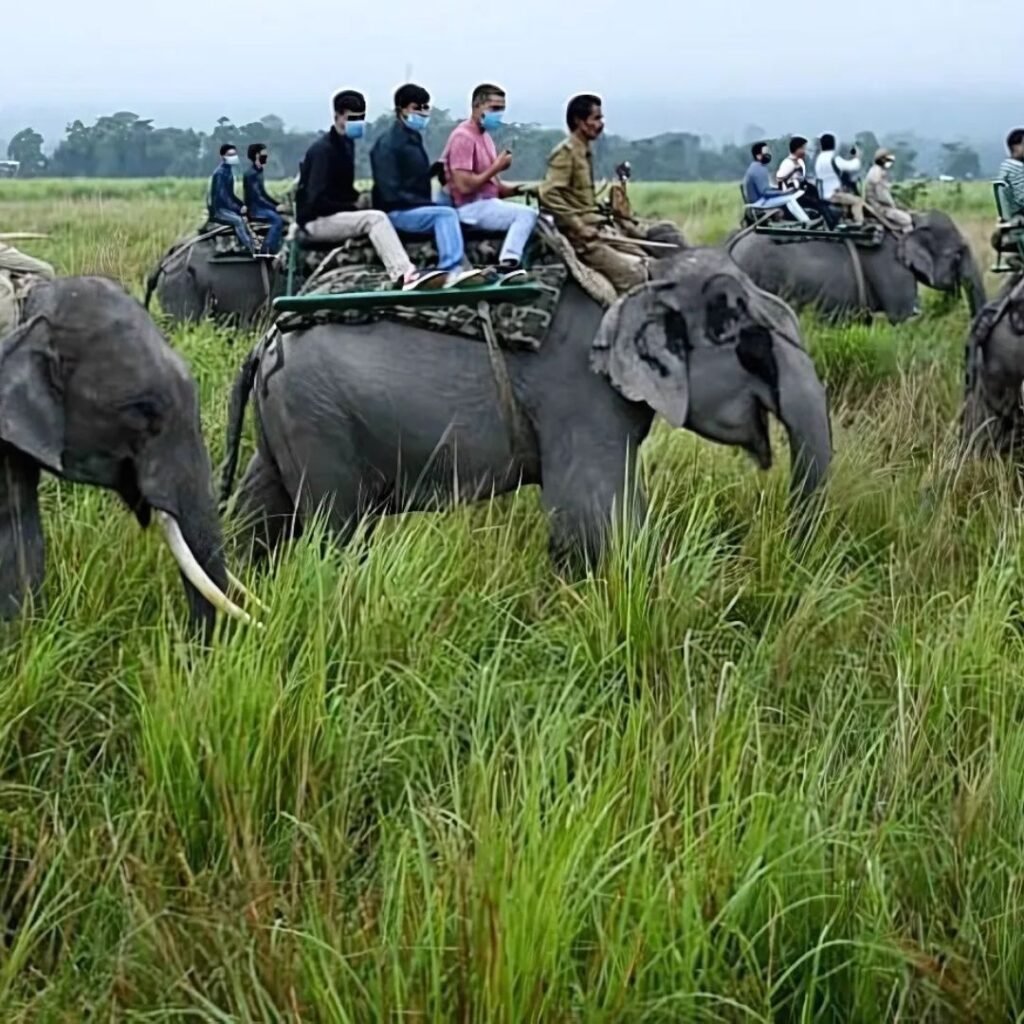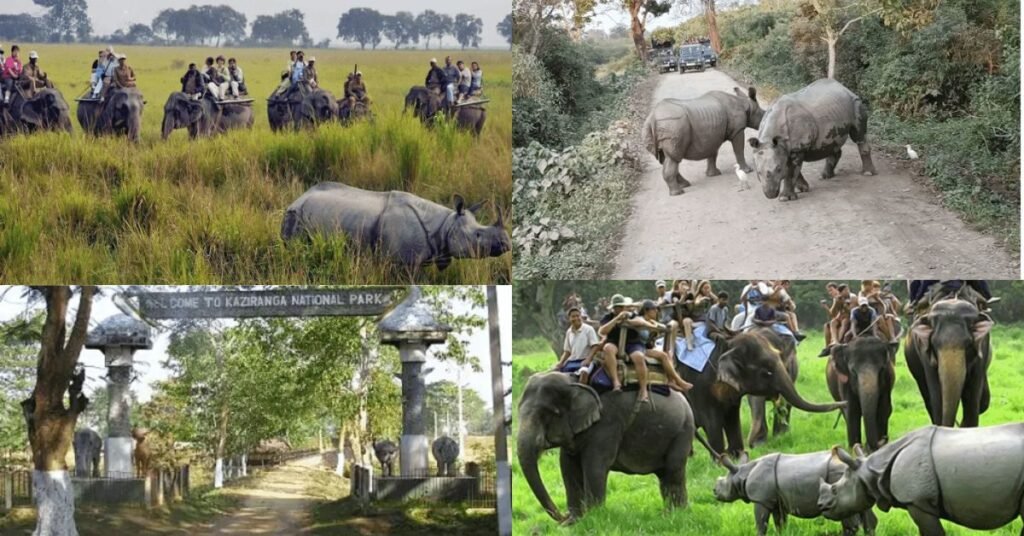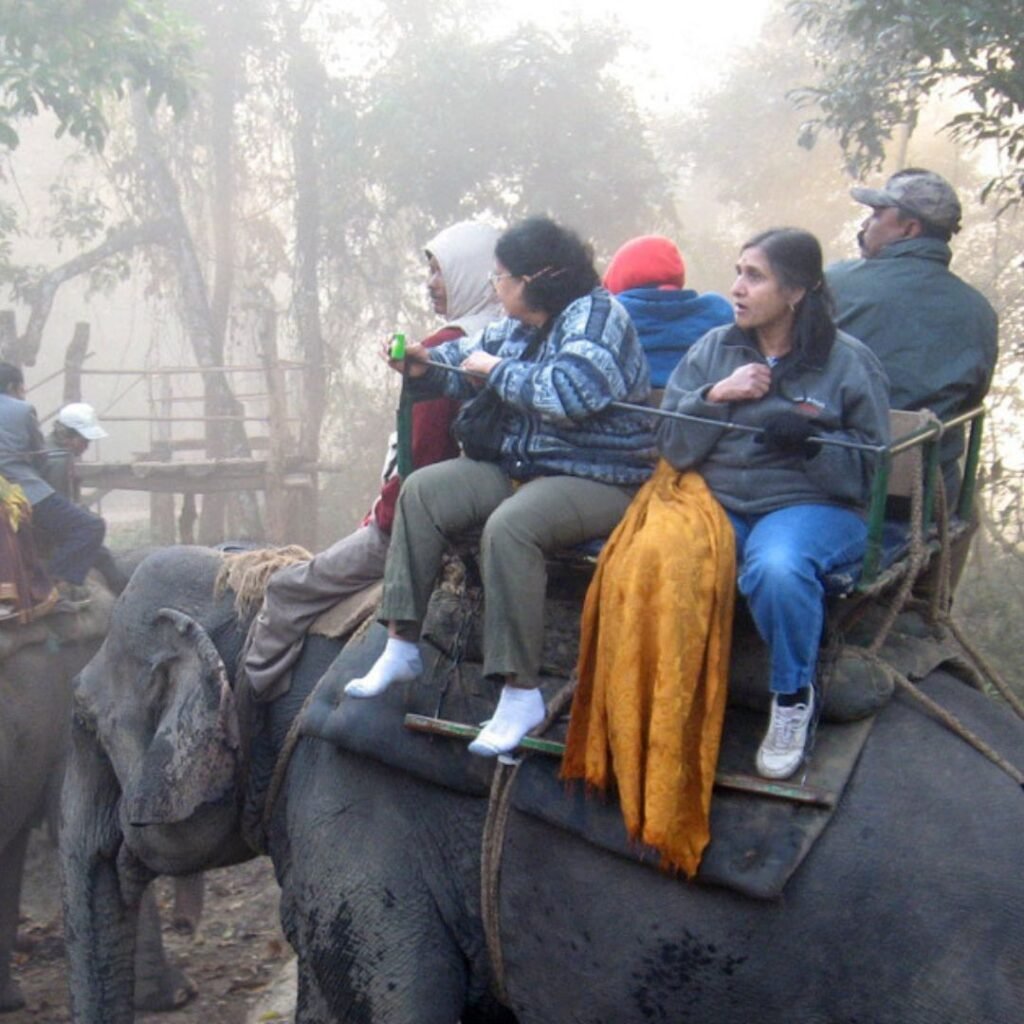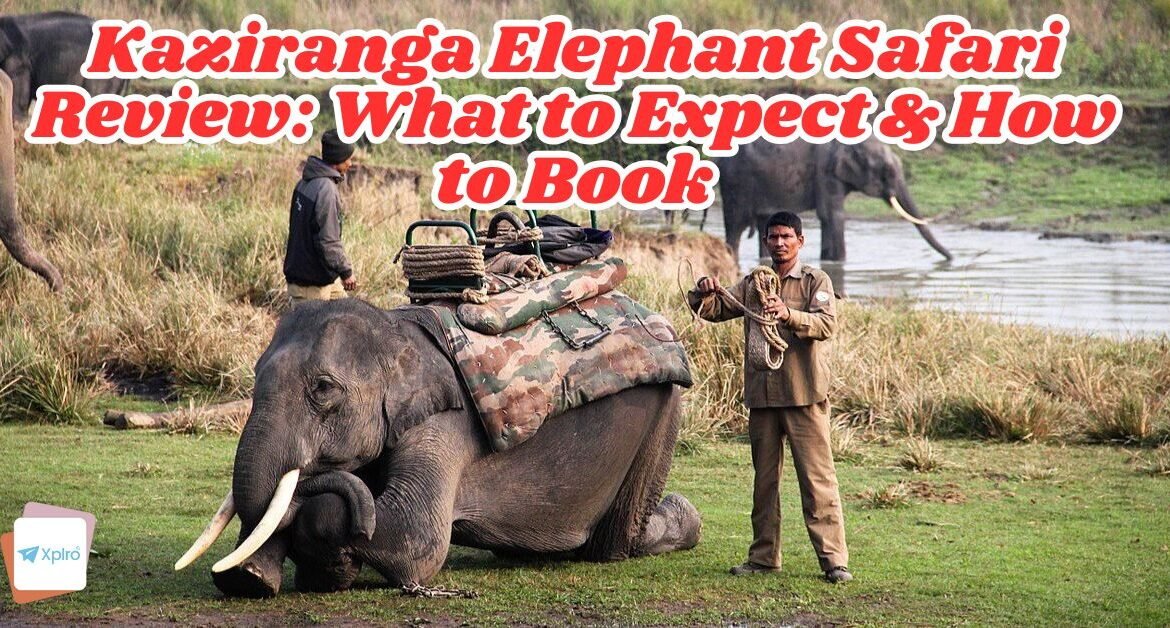Kaziranga Elephant Safari Review: If there’s one experience in India that brings you face-to-face with untamed wilderness while riding atop a gentle giant, it’s the Kaziranga Elephant Safari. Nestled in the heart of Assam, Kaziranga National Park is a UNESCO World Heritage Site and the proud home of the world’s largest population of the endangered one-horned rhinoceros. At Xplro.com, we ventured into this iconic park to offer an honest, first-hand Kaziranga Elephant Safari Review — exploring its authenticity, wildlife encounters, booking process, ideal timing, and everything in between.
- Why Choose an Elephant Safari in Kaziranga?
- Kaziranga Safari Zones Comparison
- Kaziranga Elephant Safari Timings and Duration
- Kaziranga Elephant Safari Charges (2025 Update)
- Best Time to Visit for Elephant Safari
- How to Book the Kaziranga Elephant Safari
- Wildlife You Can Expect to See
- Recommended Stays Near Kaziranga
- Responsible Travel & Dos and Don’ts
- Is the Kaziranga Elephant Safari Family-Friendly?
- Final Thoughts: Is It Worth It?
- Conclusion
- FAQs
Why Choose an Elephant Safari in Kaziranga?

Unlike a jeep safari, which maintains a certain distance from the terrain, elephant safaris allow you to get closer to the wildlife, especially rhinos grazing just a few feet away. This silent, non-intrusive mode of travel ensures minimal disturbance to animals, offering a rare chance to observe them in their natural habitat.
Key Highlights:
- Close encounters with one-horned rhinos.
- Elephant ride through tall grasslands and wetlands.
- Early morning expeditions that reveal the raw beauty of the jungle.
- Perfect for photographers and wildlife enthusiasts.
Our Experience: An Honest Review from Xplro.com
Our journey began at Kohora (Central Range), the most popular entrance to Kaziranga National Park. The safari started just after dawn, around 5:30 AM, when the jungle was waking up. The chill in the air, the mist hanging low over the tall elephant grass, and the rhythmic sway of the elephant beneath us created an atmosphere that felt straight out of a Rudyard Kipling tale.
We spotted:

- 4 rhinos, including a mother and calf.
- A herd of wild buffaloes.
- Several swamp deer, and
- A stunning array of wetland birds — pelicans, herons, and eagles.
Our mahout (elephant handler) was highly experienced and shared fascinating trivia throughout the ride. The elephant moved smoothly, undeterred by the marshy ground, and took us to areas where even jeeps couldn’t go.
“If you’re visiting Kaziranga, don’t skip the elephant safari. It’s the most immersive way to connect with this biodiverse wonderland.”
Kaziranga Safari Zones Comparison
| Safari Zone | Duration | Cost (per vehicle/person) | Wildlife Spotted | Best For |
|---|---|---|---|---|
| Central (Kohora) | 2 hours (Jeep) 1 hour (Elephant) | ₹4,000+ (Jeep) ₹1,500+ (Elephant) | Rhinoceros, Wild Buffalos, Swamp Deer | First-time visitors, diverse sightings |
| Western (Bagori) | 2 hours (Jeep) 1 hour (Elephant) | ₹4,000+ (Jeep) ₹1,500+ (Elephant) | High concentration of Rhinoceros, Wild Buffalos | Photographers, high-probability rhino sightings |
| Eastern (Agaratoli) | 2 hours (Jeep) N/A (Elephant) | ₹5,000+ (Jeep) | Migratory Birds, Otters, Great Hornbills | Birdwatchers |
| Burapahar (Ghorakati) | 2 hours (Jeep) N/A (Elephant) | ₹5,500+ (Jeep) | Hoolock Gibbons, Quiet atmosphere | Tranquility, specific primate sightings |
Tip: Choose Bagori if you want fewer crowds and excellent rhino sightings.
Kaziranga Elephant Safari Timings and Duration
Elephant safaris are only conducted in the morning, typically in two shifts:
| Shift | Timing | Duration |
|---|---|---|
| 1st | 5:30 AM to 6:30 AM | ~1 Hour |
| 2nd | 6:30 AM to 7:30 AM | ~1 Hour |
Pro Tip from Xplro: Book the 1st shift for misty, golden light perfect for wildlife photography.

Kaziranga Elephant Safari Charges (2025 Update)
Prices vary for Indian vs foreign tourists, and each elephant carries 3–4 persons max. Charges are approximate and subject to change.
- Jeep Safari (per vehicle): Roughly ₹4,000–₹5,500 per jeep for Indian nationals, depending on the zone. It can cost more for foreign nationals.
- Elephant Safari (per person): Around ₹1,500 per person for Indian nationals, significantly more for foreign nationals.
- Park Entry Fee: In addition to the safari vehicle cost, there is a separate park entry fee (approximately ₹115 for Indians).
Safari tickets must be booked a day in advance from the park gate counters or via your hotel/travel agent.
Best Time to Visit for Elephant Safari
Kaziranga is open from November to April, and elephant safaris are not available during monsoons due to flooding.
| Month | Safari Quality | Notes |
|---|---|---|
| Nov–Feb | Excellent | Clear skies, great rhino visibility |
| Mar–Apr | Very Good | Slightly hot, fewer crowds |
| May–Oct | Closed | Park remains shut due to rain |
How to Book the Kaziranga Elephant Safari
Booking an elephant safari in Kaziranga is not available online for individuals. Here’s how you can secure your spot:
Offline Booking: Kaziranga Elephant Safari Review
- Visit the Kaziranga Tourism Office at Kohora or Bagori.
- Reach by 4 PM a day prior.
- Carry valid ID proof (Aadhaar, passport).
- Mention preference for first shift if possible.
Through Hotel or Travel Agent:
- Most lodges and travel agencies offer pre-arranged bookings.
- Cost may include service charges.
- Reliable for foreign tourists with limited local access.
Pro Tip: Always ask for an official receipt and verify elephant safari zone and shift.
Wildlife You Can Expect to See
While rhinos are the main attraction, Kaziranga’s diverse ecosystem offers much more.
Most Common Sightings:
- One-horned rhinoceros
- Wild Asian elephants
- Swamp deer (barasingha)
- Indian hog deer
- Water buffaloes
- Storks, pelicans, eagles, and kingfishers
Rare But Possible:
- Bengal tiger (usually spotted in jeep safari)
- Leopards
- Python and monitor lizards
- Otters near water bodies
Don’t forget your zoom lens and binoculars!
Recommended Stays Near Kaziranga
| Resort Name | Type | Distance from Park | Price/Night |
|---|---|---|---|
| Iora – The Retreat | Luxury | 1 km | ₹6,500 |
| Wild Grass Lodge | Mid-Range | 2 km | ₹3,200 |
| Bonhabi Resort | Budget | 800 m | ₹2,000 |
Tip: Book rooms near Kohora or Bagori for easy early-morning access.
Responsible Travel & Dos and Don’ts
Kaziranga is an eco-sensitive area. Respecting local customs and wildlife is crucial.
Dos:
- Wear neutral-colored clothes
- Maintain silence during the ride
- Tip your mahout
- Follow park rules and timings
Don’ts:
- Avoid plastic and littering
- Don’t shout or disturb animals
- Don’t feed or touch any wildlife
- Avoid flash photography
Is the Kaziranga Elephant Safari Family-Friendly?

Absolutely! Elephant safaris are safe for children and seniors, provided they’re comfortable with early mornings and a slow-moving ride. The ride is gentle, stable, and conducted under strict regulations.
Tip: Carry light snacks and water for kids, and use sunscreen and caps.
Jeep vs. elephant safari comparison
| Feature | Jeep Safari | Elephant Safari |
|---|---|---|
| Experience | Covers more ground, but the noise can startle animals. | Offers close, quiet encounters, especially with rhinos. |
| Coverage | Can explore all four main zones of the park. | Limited to specific areas within the Central (Kohora) and Western (Bagori) ranges. |
| Viewpoint | Ground-level view, which can be obscured by tall grass. | Elevated perspective, offering a clear view over tall elephant grass. |
| Speed | Faster and more intensive, allowing for greater exploration. | Slower, allowing for a more immersive and serene experience. |
| Availability | Two shifts daily (morning and afternoon). | Two slots in the early morning only. |
| Ethical Aspect | Less controversial than elephant rides, which are criticized for animal cruelty. | Critics point to ethical concerns regarding the taming and handling of elephants. |
Also Visit
Uttarakhand Trekking Tour Operators
Behind the Scenes with Xplro.com
At Xplro, we do more than just write — we travel, test, and review experiences so our readers get reliable information. Our 2025 visit to Kaziranga included:
- Multiple safaris (both jeep and elephant)
- Interviews with local guides and mahouts
- Photography sessions at dawn and dusk
- Interaction with conservation officials
This blog is the result of on-ground research and genuine traveler feedback — not AI-spun fluff.
Final Thoughts: Is It Worth It?
Yes, and then some.
The Kaziranga Elephant Safari is more than just a tourist activity. It’s a moment of quiet connection with nature — where you float through prehistoric landscapes on the back of a living relic. You come for the rhinos, but you leave with stories etched in your heart.
Conclusion
Whether you’re a wildlife photographer, nature lover, family traveler, or eco-conscious explorer, this Kaziranga Elephant Safari Review should convince you to make it a priority in your itinerary. Remember to book in advance, respect the ecosystem, and soak in the unfiltered jungle experience.
For more real reviews, booking hacks, and destination insights, visit Xplro.com — your window to authentic travel in India and beyond.
FAQs
1. What is the Kaziranga Elephant Safari?
- The Kaziranga Elephant Safari is a guided wildlife experience conducted within the grasslands of Kaziranga National Park in Assam. Unlike jeep safaris, this safari is done on the back of a trained elephant, allowing tourists to move quietly through marshy terrain and get closer to iconic animals like the one-horned rhinoceros. It is one of the most popular and intimate ways to explore Kaziranga’s diverse wildlife.
2. Is an elephant safari better than a jeep safari in Kaziranga?
- While both have their own appeal, the elephant safari offers a more immersive and close-up wildlife viewing experience. On an elephant, you can venture into deeper parts of the tall grasslands where jeeps cannot go. The slow and silent nature of the ride also increases your chances of spotting rhinos from just a few feet away, which is often not possible on a jeep safari.
3. How much does an elephant safari cost in Kaziranga?
- The cost of an elephant safari in Kaziranga varies depending on nationality and booking method. For Indian nationals, the price generally ranges between ₹900 and ₹1,250 per person. For foreign tourists, the cost is higher and may fall between ₹2,000 and ₹2,500. These prices do not include park entry or camera charges, which are additional.
4. How long does the elephant safari last?
A standard elephant safari ride in Kaziranga lasts for approximately one hour. During this time, visitors are taken through the best wildlife zones of the park, particularly in the early morning when animal activity is at its peak and the environment is calm and photogenic.
5. What are the safari timings in Kaziranga?
- Elephant safaris in Kaziranga are conducted only in the morning hours. There are two shifts each day — the first begins at around 5:30 AM and the second around 6:30 AM. Each shift lasts for about an hour. There are no evening elephant safaris available due to park regulations and animal activity patterns.
6. Can I book the Kaziranga Elephant Safari online?
- Unfortunately, individual tourists cannot book the Kaziranga Elephant Safari online. All bookings are done offline, either through the official forest department counters near the entrance gates or through local hotels and registered travel agencies. It is recommended to book your slot a day in advance as demand is high and seats are limited.
7. Which range is best for elephant safari in Kaziranga?
- Among the different zones, the Bagori (Western) Range is often regarded as the best for an elephant safari. It is known for excellent visibility of rhinos, fewer crowds, and easier access. The Kohora (Central) Range is also popular and more commercialized, but Bagori tends to offer a more tranquil and rewarding wildlife viewing experience.
8. Is the elephant safari in Kaziranga safe?
- Yes, the elephant safari is considered very safe for tourists. The elephants are well-trained and managed by experienced mahouts who are familiar with both the terrain and the wildlife. The safari is slow-paced and strictly supervised by forest officials, ensuring a secure and peaceful experience for visitors.
9. Is the Kaziranga Elephant Safari eco-friendly?
- Compared to jeep safaris, the elephant safari is more eco-sensitive as it causes less disturbance to the habitat and the animals. The elephants follow narrow natural trails without destroying vegetation, and the quiet movement ensures a low carbon footprint while offering an authentic jungle experience.
10. What wildlife can I see on an elephant safari?
- The highlight of the elephant safari is undoubtedly the one-horned rhinoceros, which is commonly spotted up close during the ride. In addition, you may encounter swamp deer, hog deer, wild water buffaloes, elephants, and a wide variety of wetland birds such as storks, pelicans, and kingfishers. Tigers are rarely seen on elephant safaris but are present in the park.
11. Are children allowed on elephant safaris in Kaziranga?
- Children are welcome on elephant safaris in Kaziranga, provided they are accompanied by adults. Typically, children above five years of age are allowed to ride comfortably. The ride is smooth and safe, but parents should ensure their child is comfortable with early mornings and the jungle environment.
12. When is the best time to go on an elephant safari in Kaziranga?
- The best time to experience the Kaziranga Elephant Safari is between November and February. During these months, the weather is pleasant, the skies are clear, and visibility is excellent. This period is also ideal for spotting rhinos and migratory birds. By late March, the park becomes warmer, and sightings may reduce slightly.
13. Is photography allowed during the elephant safari?
- Photography is allowed and even encouraged during the safari, as the experience offers many incredible photo opportunities. However, you will need to pay a camera fee at the entrance gate — typically ₹100 for still cameras and a higher fee for video recording. It’s best to carry a zoom lens for wildlife shots.
14. How many people are allowed on one elephant?
- Each elephant can carry a maximum of three to four people, depending on the elephant’s size and the weight of the passengers. The number is regulated to ensure the comfort and safety of both the animal and the visitors. Solo rides are generally not available.
15. Is tipping the mahout necessary?
- While tipping is not mandatory, it is considered a kind gesture and is highly appreciated by the mahouts, who spend years building bonds with the elephants and guiding tourists. A small tip of ₹100 to ₹200 is a respectful way to thank them for their service and insights during the safari.
16. Are elephant safaris available during the monsoon?
- No, elephant safaris are not available during the monsoon season. Kaziranga National Park remains closed to tourists from May to October due to heavy rainfall and frequent flooding, which makes the terrain unsafe for both animals and visitors.
17. Do I need a permit for the elephant safari?
- Yes, a permit is required to participate in the elephant safari. These permits are issued by the forest department and are usually included when you book through the park counters or a travel agency. You must present valid ID proof to obtain the permit.
18. Can I choose which range to take the safari in?
- Yes, you can express your preference for a particular range, such as Bagori or Kohora, during booking. However, allocation depends on availability and the number of tourists, so it is advisable to book early and confirm your range with the issuing authority or your hotel.
19. Can senior citizens join the elephant safari?
- Senior citizens can certainly enjoy the elephant safari, as the ride is steady and the boarding platforms make it easy to mount the elephant. As long as they are fit enough to wake up early and manage light movement, the safari is a gentle and enjoyable experience for older travelers.
20. Is the Kaziranga Elephant Safari worth it?
- Absolutely. The Kaziranga Elephant Safari offers one of the most unforgettable wildlife experiences in India. Floating silently through the tall grasses on an elephant while watching a rhino graze just meters away is something truly magical. According to Xplro.com’s expert review, this safari is a must-do for nature lovers, photographers, and anyone seeking a close connection with the wild.
21. How can I book a Kaziranga safari online for 2025?
- To book a safari, visit an official online booking portal, such as kazirangasafari.in. Select the safari zone, type (jeep or elephant), date, and time slot. Enter the required visitor details and complete the payment online to confirm the booking.
22. Is it better to book the safari online or in person?
- Online booking is highly recommended, particularly during the peak season from November to April. Safari slots are limited and often sell out in advance. Booking online guarantees a spot and prevents potential disappointment.
23. Is Kaziranga National Park open year-round?
- No. Kaziranga typically closes during the monsoon season, from May 1st to October 31st, due to heavy flooding. It reopens for visitors in early November, but it’s best to check the official website for exact dates.




